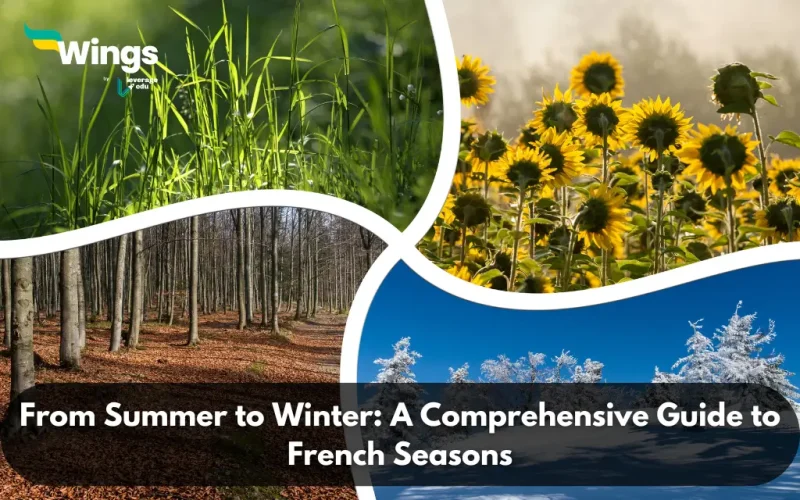The Earth’s tilt and its journey around the sun bring a beautiful rhythm to our lives: the changing seasons. These seasonal shifts not only influence our daily routines but also inspire artists, writers, and everyday conversations. If you’re learning seasons in French, understanding them is a fantastic way to expand your vocabulary and explore French culture in depth. So, buckle up and get ready for a whirlwind tour – from sunny été (summer) to cozy hiver (winter) – through the seasons in French. Ready, set, lingo!
This Blog Includes:
The Four Seasons in French (With Pronunciation)
Let’s start with the basics. Here are the four seasons in French, along with their pronunciations (represented in International Phonetic Alphabet):
- Le printemps (leh-prohn-tom) – Spring
- L’été (leh-tay) – Summer (note the apostrophe before “été” as it starts with a vowel)
- L’automne (lo-tomnh) – Autumn (another apostrophe friend)
- L’hiver (lee-vayrh) – Winter
Talking About the Seasons in French
Now that you know the names of seasons in French, let’s explore how to talk about them. Unlike English, French uses prepositions “en” (in) and “au” (to) with the seasons. Their usage with examples is as follows:
- En is used for general statements about a season or when the season is the object of the sentence.
- J’adore passer mes vacances en été. (I love spending my holidays in summer.)
- Au is used to indicate the beginning or the duration of a season.
- Nous décorons la maison au printemps. (We decorate the house in spring.)
Seasons in French: A Peek into Each Season
Le printemps (Spring)
Spring (April-June) bursts onto the scene in France, bringing with it longer days, blooming flowers, and a sense of renewal.
- Vocabulary: fleurs (flowers), oiseaux (birds), papillons (butterflies), Pâques (Easter)
- Activities: French people cherish spring with outdoor activities like picnics, strolling through parks, and attending flower festivals.
L’été (Summer)
Summer (June-September) is the season of sunshine! With warm weather and long daylight hours, it’s no wonder it’s a favorite time for many.
- Vocabulary: plage (beach), soleil (sun), vacances (holidays), baignade (swimming)
- Activities: Summertime in France beckons people to the beaches, charming outdoor cafes, and vibrant summer festivals.
L’automne (Autumn)
Autumn (September-November) paints the French countryside in warm hues of red, orange, and yellow. It’s a season of harvest and cozy evenings.
- Vocabulary: feuilles (leaves), citrouilles (pumpkins), vendanges (grape harvest), Halloween
- Activities: Fall is a time for enjoying the bounty of the harvest, with farmers markets overflowing with fresh produce and celebrations like Beaujolais Nouveau, a new wine release.
L’hiver (Winter)
Winter (December-March) brings cooler temperatures, shorter days, and sometimes, snow! But French winter holds its own charm.
- Vocabulary: neige (snow), feu (fire), Noël (Christmas), sports d’hiver (winter sports)
- Activities: Winter offers opportunities for cozy nights by the fireplace, enjoying festive meals, and indulging in winter sports like skiing in the French Alps.
Fun Facts and French Folklore
Learning about the seasons in French goes beyond vocabulary and grammar. Here are some tidbits about French seasons and folklore that will help you understand:
French Riviera vs. French Alps
The diverse geography of France means the seasons are experienced differently across regions. The French Riviera basks in a warm Mediterranean climate, extending its summer well into September, while the French Alps experience colder winters with snow-capped peaks.
Seasonal Celebrations
- Le 1er mai: May Day, a celebration of workers.
- Le 14 juillet: Bastille Day, France’s national holiday.
- La Toussaint: All Saints’ Day, a day to commemorate deceased loved ones.
Seasonal Food and Drinks
Each season boasts its own culinary delights. Summer calls for refreshing rosé wine and salade niçoise (Nicoise salad), while winter warms you up with a rich boeuf bourguignon (beef Burgundy) and a cup of hot chocolate. Don’t forget the crêpes enjoyed year-round!
Learning French Through the Seasons
Exploring French culture through the lens of the seasons in French is a delightful way to boost your language skills. Here are some ideas:
- Watch French movies or TV shows set in different seasons.
- Listen to French music that evokes seasonal themes.
- Find a language exchange partner and discuss your favorite seasonal activities.
- Read French poems or short stories that describe the beauty of each season.
FAQs
Ans: Given below are the 4 seasons in French in order:
1. Le printemps (Spring)
2. L’été (Summer)
3. L’automne (Autumn)
4. L’hiver (Winter)
Ans: The translation of the English word seasons in French is “les saisons”.
Ans: Toutes les saisons (tooh-lay-sayzon) is the literal translation of the phrase “all the seasons”.
So this was all about seasons in French, their pronunciation along with some fum cultural facts. Stay tuned to Leverage Edu for more informative content on the French language daily.
 One app for all your study abroad needs
One app for all your study abroad needs















 60,000+ students trusted us with their dreams. Take the first step today!
60,000+ students trusted us with their dreams. Take the first step today!